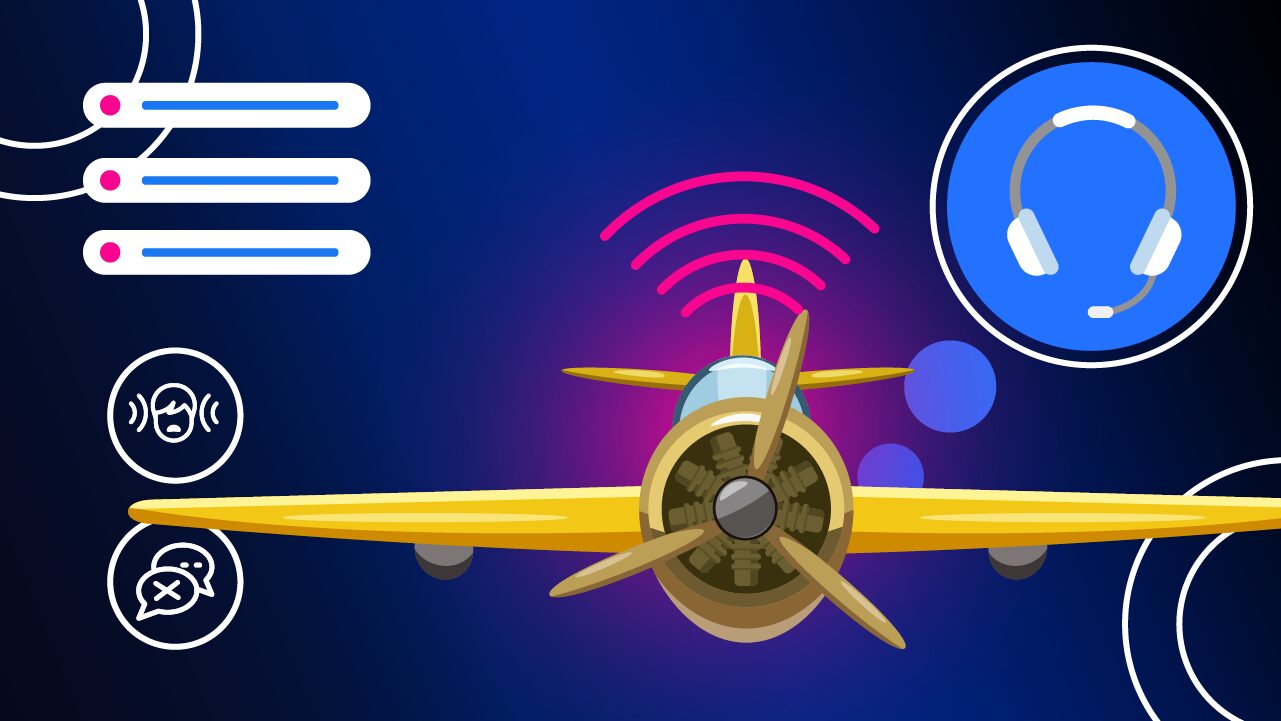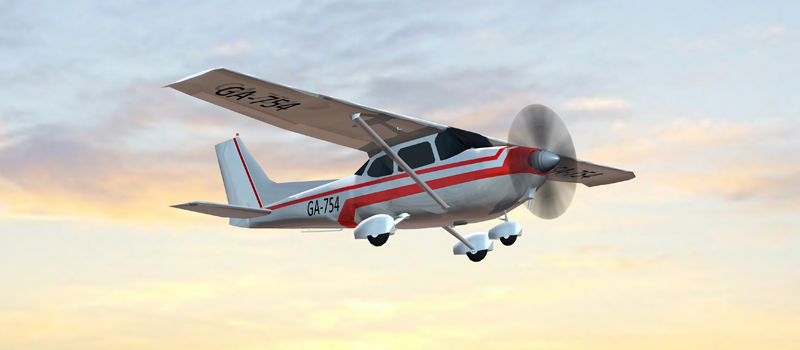-
Preflight Preparation
- Learn the Phonetic Alphabet
- Understand the Content of Radio Calls
- Rehearse ATC Interactions
-
Inflight Tips
- Write Down the Radio Frequencies
- Think Before You Speak
- Be Ready to Receive the Clearance
- Enforce a Sterile Flight Deck
-
Overcoming Common Challenges
- Incorrect Readback
- Congested Radio Frequencies
- Fast Speaking Controllers
-
IFR vs VFR Radio Calls
-
Towered Airport Radio Communication Explained (With Examples)
- Ground
- Departing Tower
- Approach
- Arriving Tower
-
Non-towered Airport Communication Explained (With Examples)
- Required Radio Calls
- Flight Following
-
Emergency Radio Communication
-
Conclusion
ATC communication is one of the most challenging parts of flight training.
Getting it wrong can be embarrassing at best and deadly at worst.
But in this guide, we’ll cut through the complexity and help you become confident and safe on the radio.
We won’t help you practice your pilot voice, though…
Preflight Preparation

Talking to ATC can undoubtedly be stressful when you first start. It is yet another hurdle to overcome when learning to fly.
Before getting into an aircraft and talking to ATC for real, prepare for the experience. Learning ATC communication basics on the ground will make your in-flight practice smoother.
Here are some preflight tips to build your radio confidence.
Learn the Phonetic Alphabet
Pilots and controllers use the phonetic alphabet to communicate clearly. The alphabet uses words to replace letters to reduce confusion over the airwaves.
Learning this alphabet from A to Z is key. It’s used for aircraft registration, airport taxiways, holding points, weather broadcasts, and more. Whenever a pilot or controller needs to say a letter, they use the phonetic alphabet equivalent.
For example, the letter A is “Alpha,” and B is “Bravo.”
You can find the complete alphabet in the FAA’s Learning Center Library. Make sure you know it by heart before pressing the push-to-talk button.
Understand the Content of Radio Calls
Before talking to ATC, learn how pilots and controllers interact.
The FAA’s Aeronautical Information Manual (AIM) is a fantastic resource. AIM Chapter 4, section 2 covers the radio technique and phraseology you need to know.
It is easy to get lost in the sea of aviation terminology. The list of acronyms and phrases almost seems like a different language.
Here are a few common aviation terms you’ll encounter during ATC interactions.
- WILCO – will comply with the instructions.
- Standby – wait until the next instruction.
- Unable – cannot comply with the request.
- Say your intentions – what do you want to do?
- Touch and go – aircraft lands on the runway and then accelerates to take off again.
- Full stop – a landing that comes to a stop.
- Cleared for the option – authorization to make a touch-and-go, low approach, missed approach, stop-and-go, or full-stop landing.
To learn the complete list of words and phrases, check out the FAA’s Pilot/Controller Glossary.
While you’re studying the phraseology, start listening to ATC. The easiest way to do this is online with LiveATC. You can listen in on real exchanges between ATC and pilots. Keep your glossary handy and look up words or phrases you don’t know.
Check out our step-by-step guide to listening to live ATC for more info.
Rehearse ATC Interactions
Have a flight instructor or fellow student pilot act as ATC while you “chair fly.”
Practice requesting and receiving clearances. The more you do this, the more second nature it will be when you’re in the aircraft.
Inflight Tips

You are ready to step into an aircraft and put your hard work to the test!
Before you request your first clearance, follow these inflight tips. They will make talking to ATC as smooth as possible.
Write Down the Radio Frequencies
Having a list of the correct radio frequencies is crucial. Before you set foot in the airplane, determine who you’ll need to contact during your flight.
At a towered airport, frequencies might include ground, tower, ATIS, and departure control. At non-towered airports, you’ll have CTAF, AWOS, and maybe approach control for flight following. Determine who you’ll need to talk to at your arrival airport.
Write down the correct frequencies on a piece of paper or your electronic flight bag (EFB). That way, switching between frequencies will be seamless. This will reduce your workload and stress and let you focus on your radio calls.
Think Before You Speak
Before you hit the push-to-talk button, think about what you will say. Although no one expects perfection from a student pilot, the fewer “umms” and “uhhs,” the better. ATC expects clear and concise communication.
This is where all your preflight study and practice will pay off. Your radio calls will go smoothly once you know what to say, how to say it, and the expected ATC response.
Preparation reduces your chances of messing up a radio call or saying the wrong thing. Shorter radio calls also keep the frequency open for ATC and other pilots.
Be Ready to Receive the Clearance
After you have requested a clearance from ATC, ensure you are ready to receive it.
First, be mentally prepared for the clearance. If it’s a taxi clearance, familiarize yourself with routes to the active runway. For a departure clearance, expect at least a heading, altitude, and further instructions. For a flight following clearance, use the CRAFT mnemonic.
Second, have a pen and paper or EFB ready to write down the given clearance. You can then read it back directly from your notes so you know that what you have written down is correct.
You must read back the clearance precisely and in its entirety. This will confirm to ATC that you understand the clearance.
Enforce a Sterile Flight Deck
We all know that there can be a lot of distractions when flying. Communicating about non-flying topics is one of them.
Any external chatter is a distraction. It could lead to a mistake or an incorrect readback.
When you talk to ATC, limit non-essential flight deck conversations. Make sure you’ve briefed all occupants about when they can – and can’t – talk during the flight.
Overcoming Common Challenges

You will undoubtedly encounter some challenges when talking to ATC. It happens to all aviators.
We’ve compiled a list of common ATC challenges you may face and provided tips for overcoming them.
Incorrect Readback
Every pilot has experienced an incorrect readback. Although it may seem embarrassing at the time, such mistakes are common. We are only human, after all.
The best advice here is to remain calm. Pause, take a deep breath, and try again. These sorts of errors happen when we are nervous, so relax and take a second to collect your thoughts.
Don’t be afraid to mess up. It’s all a part of the aviation journey.
Congested Radio Frequencies
Busy frequencies quickly become congested with transmissions. It can be hard to get a word in, making communication difficult.
Talking to ATC on a busy frequency can be intimidating. There is a constant flow of radio calls, and you have to pick your timing.
Prepare what you will say to the controller so your radio call is clear, concise, and correct. When you find that gap in radio calls, confidently transmit your message. Don’t feel pressured to talk extra fast. A slow but smooth radio call is more efficient than a fast, garbled one.
Fast Speaking Controllers
Speaking of talking fast, no one enjoys deciphering words at a hundred miles a minute. Sometimes, it’s the controller who is fast-talking. Their instructions can be hard to understand and tough to follow.
Unfortunately, quite a few controllers in the industry speak fast. You’ll find them in busy airspace, where they’re moving volumes of jet aircraft. These jet pilots have years of experience and repeatedly make the same radio calls.
Sometimes, controllers simply forget that their instructions are hard for new pilots to understand. If you can’t understand a clearance because it is too fast, simply ask them to “say again.” Remember, ATC exists to support pilots.
It might seem embarrassing at the time, but it is much safer than carrying out the wrong instructions.
IFR vs VFR Radio Calls

Different flight rules have different radio calls. When starting out, you will fly under visual flight rules (VFR). You will learn the basic radio calls for towered and non-towered airports.
Instrument flight rules flying (IFR) is more procedural, meaning more radio calls. IFR flights must always be in radio contact with ATC when in controlled airspace.
By the time you learn IFR communications and operations, you will be competent in radio calls. This will make it easier to pick up any of the new terminology.
Towered Airport Radio Communication Explained (With Examples)

Let’s take a look at some real-life interactions with ATC.
We have prepared an example flight with radio calls from startup to shutdown.
Throughout the examples, notice the pilot using the four Ws basic structure for radio calls:
- Who you are talking to.
- Who you are.
- Where you are.
- What you want/where you are going.
The four Ws are an excellent way to structure your transmissions.
Ground
Clearance for Departure and Taxi (Class C Airport)
Pilot: Greenwest Ground, N123AB, request VFR to Johnsonville, Cessna 172, five thousand five hundred. We’re at the general aviation ramp with Information Alpha.
Ground: N123AB, after departure, fly heading three six zero, maintain VFR at or below six thousand, departure frequency 118.3, squawk four two nine six. Advise when ready to taxi.
Pilot: After departure, fly heading three six zero, maintain VFR at or below six thousand, departure frequency 118.3, squawk four two nine six. We’re ready to taxi, N123AB.
Ground: N123AB, readback correct. Taxi to runway zero-five via Delta, Charlie.
Pilot: Taxi to runway zero-five via Delta, Charlie, N123AB.
Departing Tower
Takeoff Clearance
Pilot: Greenwest Tower, N123AB, ready for departure.
Tower: N123AB, Runway zero-five, cleared for takeoff.
Pilot: Runway zero-five, cleared for takeoff, N123AB.
Departure
Tower: N123AB, contact departure, 118.3.
Pilot: Departure on 118.3, N123AB.
Pilot: Departure, N123AB, one thousand climbing five thousand five hundred, heading three six zero.
Departure: N123AB, radar contact, two miles northeast of Greenwest. Proceed on course Johnsonville.
Pilot: On course Johnsonville, 123AB.
Approach
Transiting Class B Airspace
Pilot: Bigtown Approach, N123AB, ten miles east of Bigtown at five thousand five hundred, en route Johnsonville, request transit Class Bravo Airspace.
Approach: N123AB, Bigtown Approach, squawk four eight six two and ident.
Pilot: Squawk four eight six two and ident, N123AB.
Approach: N123AB, radar contact. You are cleared through Class Bravo airspace direct to Johnsonville, maintain five thousand five hundred.
Pilot: Cleared through Class Bravo direct to Johnsonville, five thousand five hundred, N123AB.
Arriving Class C Airspace
Pilot: Johnsonville Approach, N123AB, fifteen miles west at five thousand five hundred, landing with information Bravo.
Approach: N123AB, Johnsonville Approach, radar contact. Fly right base runway two-zero, report when established.
Pilot: Right base for runway two-zero, WILCO, N123AB.
Pilot: N123AB established right base runway two-zero.
Approach: N123AB, contact Johnsonville Tower on 118.8.
Pilot: Johnsonville Tower, 118.8, N123AB.
Arriving Tower
Landing Clearance
Pilot: Johnsonville Tower, N123AB, right base, runway two-zero.
Tower: N123AB, Johnsonville Tower, runway two-zero cleared to land.
Pilot: Cleared to land, runway two-zero, N123AB.
Taxi Clearance
Tower: N123AB, turn right on taxiway Alpha. Contact ground 121.7.
Pilot: Right on Alpha, over to ground 121.7, N123AB.
Pilot: Ground, N123AB off two-zero at Alpha, parking GA ramp.
Ground: N123AB, taxi via Echo, cross runway three-three, Foxtrot to the GA ramp.
Pilot: Echo, cross three-three, Foxtrot to the ramp, N123AB.
Non-towered Airport Communication Explained (With Examples)

At non-towered airports, ATC is not there to tell you what to do and when to do it.
So, who is keeping everyone safe?
You and other pilots.
Every pilot at the non-towered airport must provide accurate and timely position reports. This self-reporting creates a safe flying environment for all.
Required Radio Calls
The structure of the radio call stays the same but with one addition to the four W’s. You finish the radio call like you started it, with “who you are talking to.”
Many non-towered airports share the same CTAF frequency. You might accidentally pick up a transmission from a pilot at a distant airport. Repeating the airport name ensures pilots are hearing reports for the right airport.
Below are some examples of required radio calls on the ground and in the air.
Taxiing
Pilot: Maryville Traffic, N123AB, general aviation ramp, taxiing to runway two-nine, Maryville Traffic.
Departing
Pilot: Maryville Traffic, N123AB, rolling runway two-nine, climbing four thousand, departing to the east, Maryville Traffic.
Pilot: Maryville Traffic, N123AB, rolling runway two-nine, staying in the pattern, Maryville Traffic.
Arriving
Pilot: Maryville Traffic, N123AB, five miles east of the field, one thousand five hundred, overflying the field, left downwind entry for runway two-nine, Maryville Traffic.
Traffic Pattern Radio Calls
Pilot: Maryville Traffic, N123AB, downwind runway two-nine, full stop landing, Maryville Traffic.
Pilot: Maryville Traffic, N123AB, right base runway two-nine, touch and go, Maryville Traffic.
Landing
Pilot: Maryville Traffic, N123AB, final runway two-nine, full stop landing, Maryville Traffic.
Flight Following
Flight following allows ATC to give you traffic advisories along your route. Having another set of “eyes” on your flight is always a good idea.
You can often request flight following directly from a towered airport controller. Requesting flight following from approach or center controllers is just as easy.
Requesting
Pilot: Greenwest Approach, N123AB, Cessna 172, overhead Sedona VOR at five thousand five hundred, en route to Johnsonville, request flight following.
Approach: N123AB, Greenwest Approach, squawk four one one two.
Pilot: Squawk four one one two, N123AB.
Canceling
Pilot: Greenwest Approach, N123AB, request cancel flight following.
Approach: N123AB, radar service terminated, squawk VFR, frequency change approved.
Pilot: Squawk VFR, N123AB.
Emergency Radio Communication

MAYDAY
A MAYDAY call is used when the aircraft is in an emergency and requires immediate assistance.
To declare a MAYDAY when talking to ATC, repeat MAYDAY three times. Include who you are talking to, who you are, the nature of the issue, and your intended plan.
Pilot: MAYDAY, MAYDAY, MAYDAY, Greenwest Approach, N123AB, engine failure, landing in a field straight ahead.
PAN PAN
A PAN-PAN call is used when the aircraft is in a state of urgency. Unlike a MAYDAY call, PAN-PAN doesn’t require immediate assistance. However, it could evolve into an emergency later on.
To declare a PAN-PAN, use the same format as a MAYDAY call.
Pilot: PAN-PAN, PAN-PAN, PAN-PAN, Greenwest Approach, N123AB, left engine failure, requesting return to Greenwest.
Conclusion
Talking to ATC can be very challenging when first learning to fly.
The number of acronyms to remember can be overwhelming when learning aviation lingo. By practicing the principles outlined in this guide, you’ll be well on your way to radio mastery. Have you ever wondered what happens if your radio fails when landing at a towered airport? The tower can clear you to land by using a special “light gun.” Learn more about this device and how it works in this article.



